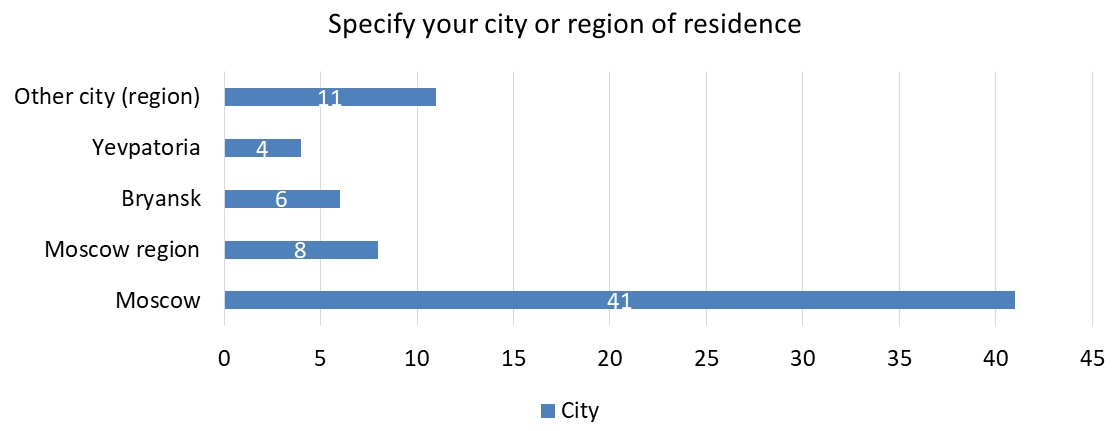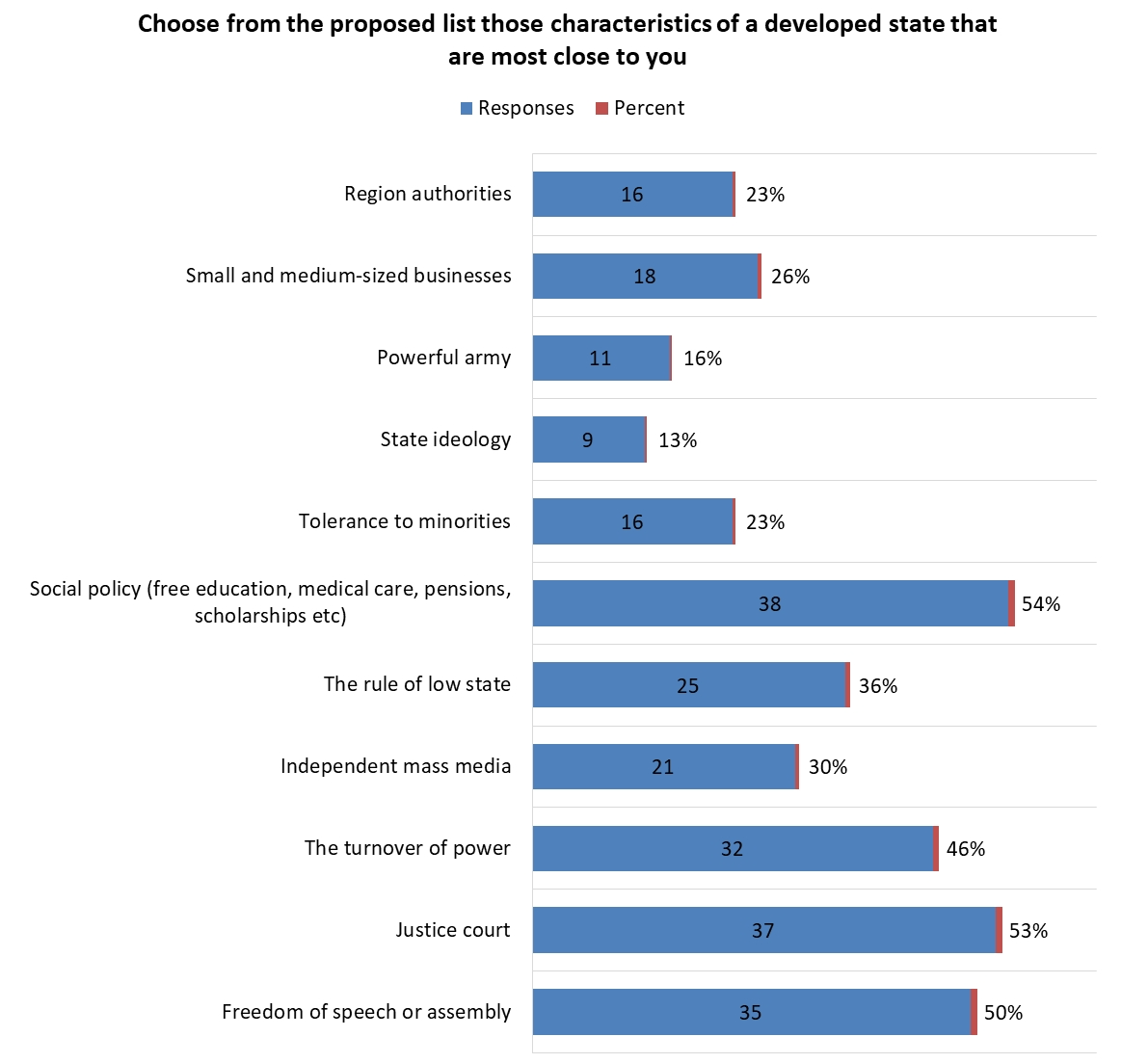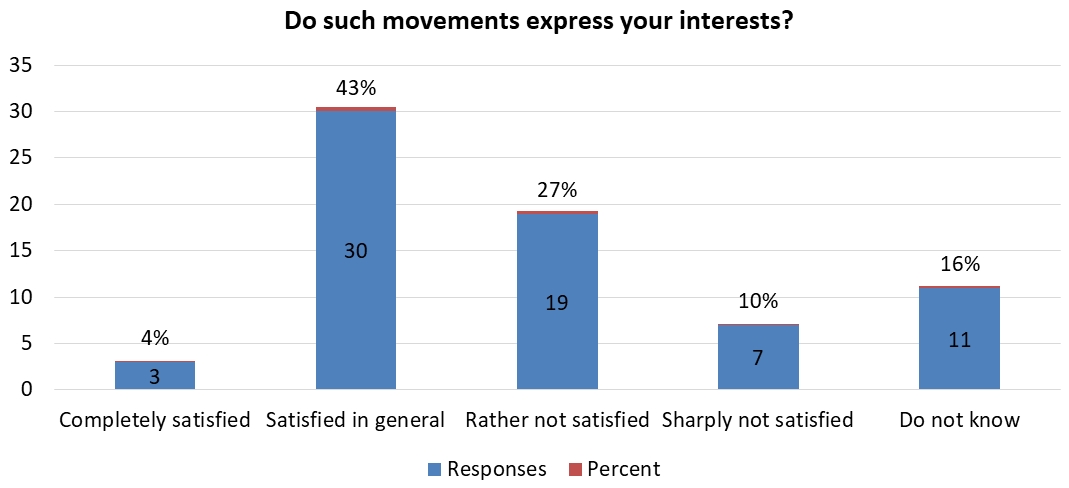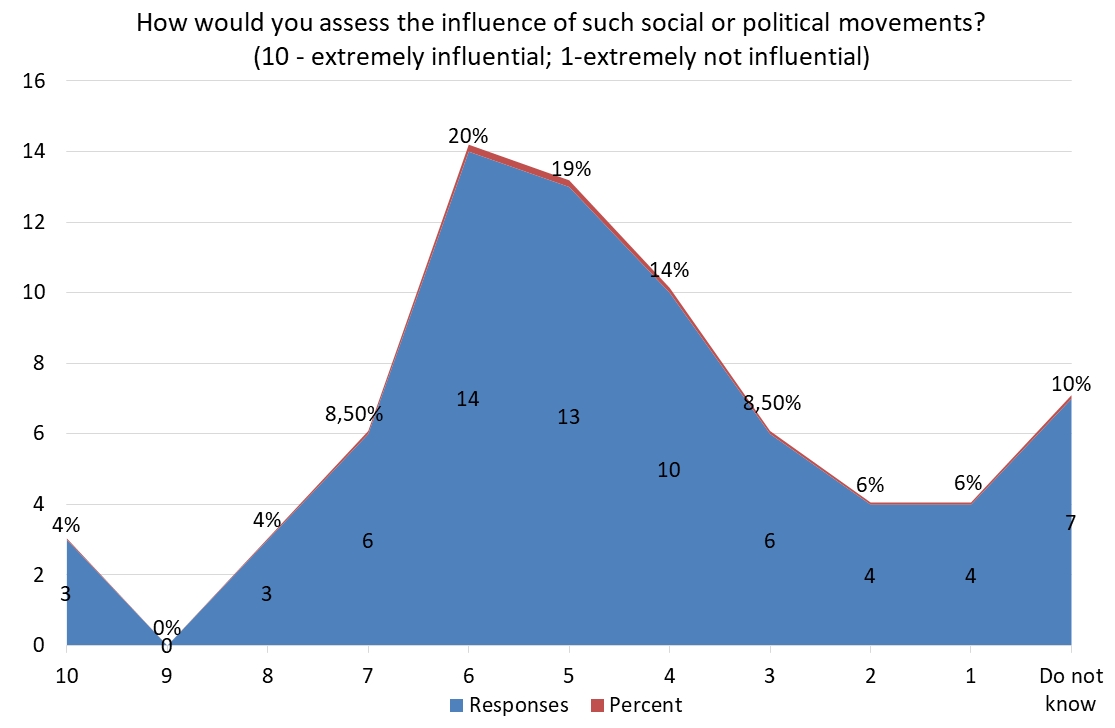ОБЩЕСТВЕННО-ПОЛИТИЧЕСКИЙ ЗАПРОС МОЛОДЫХ ЛЮДЕЙ, ИХ ИДЕАЛЫ И ОРИЕНТИРЫ
ОБЩЕСТВЕННО-ПОЛИТИЧЕСКИЙ ЗАПРОС МОЛОДЫХ ЛЮДЕЙ, ИХ ИДЕАЛЫ И ОРИЕНТИРЫ
Научная статья
Подгорный А.С.1, Власов А.А.2, Звонова Е.В.3, *
1 ORCID: 0000-002-8118-490Х;
2 ORCID: 0000-0002-2915-3495;
3 ORCID: 0000-0001-9271-8367;
1, 2, 3 Московский педагогический государственный университет (МПГУ), Москва, Россия
* Корреспондирующий автор (zevreturn[at]yandex.ru)
АннотацияВ статье молодые люди, рожденные на стыке нового тысячелетия, живущие в больших городах, рассматриваются как креативная социальная группа. Молодежь выступает активной частью общества и акцентирует запрос на преобразование общественно-политической жизни в стране. Недостаточная рефлексия данного факта объясняется методологическим наследием и недостаточным вниманием к достижениям современной социальной психологии. Проведенное эмпирическое исследование показывает, что отрицание и неприятие политических субъектов и движений, отвечающих на запросы студенческой и работающей молодежи, а также санкции, следующие за поддержку и участие в них, отстраняют молодых людей от предъявления и реализации своих взглядов, намерений и потребностей.
Ключевые слова: молодежь, общественно-политическое участие, государственные институты, политический запрос.
THE YOUTH SOCIO-POLITICAL REQUEST IN RUSSIA. IDEALS AND ORIENTING POINTS
Research article
Podgornyy A.S.1, Vlasov A.A.2, Zvonova E.V.3, *
1 ORCID: 0000-002-8118-490Х;
2 ORCID: 0000-0002-2915-3495;
3 ORCID: 0000-0001-9271-8367;
1, 2, 3 Moscow Pedagogical State University, Moscow, Russia
* Corresponding author (zevreturn[at]yandex.ru)
AbstractIn this article is about young people born at the turn of the new millennium, living in big cities are considered in the creative social group. The youth is an active part of society and focuses on the improvement of socio-political life in the country. The lack of reflection on this fact is explained by the methodological heritage and insufficient attention to the achievements of modern social psychology. The conducted empirical research shows that denial and rejection of political subjects and movements that reply on students and working youth and sanctions forward for the support and participation in these movements is suspend youth from presentation and realization they view, intends and requirements.
Keywords: youth, socio-political participation, state institutes, political request.
IntroductionRobust social processes are occurring around the world, exposing decades of accumulated contradictions and problems of social structure. The active confrontation between authority representatives and society is predicting tectonic revolution shifts that touch the major part of the civilized world. The paradoxical fact that the Russian science paradigm that long away tear up with Marxism-Leneninsm goes on to deny the availability of laws of social development fixed and formulated in the second half of 20 century. Despite on availability of many types of research and powerful social request out of the spotlight there are still has some questions about the significance of the minority in social development [8], [10]. In addition, there are present total misunderstanding differences between the content of the concepts as “revolutionary class” and “creative group”.
In Lenin’s terminology, the revolutionary class called sizeable social groups had “nothing to lose except for their chains”. This fact makes this social group the chiefest actor of revolution reforms. At the same time, in a leader of the world proletariats logic, all those who are dissatisfied with the ruling system, which in total constitute the revolutionary masses, join the revolutionary class.
However, researches that are made on relevant materials show that for first to become the engine of reforms, the social group has to possess the necessary quality – creativity. This is the unique socio-psychological phenomenon — group creativity. This phenomenon appears in the process of group formation. The group effect pretty much dominates in influence on motivating of changes, searches, and creature of strategies and realization of changes [8]. Social and cognitive interaction reduces the resistance to future cataclysms, allows group members to adapt, accept new things and find a particular form of behavior that will enable them to follow the vector of development without contradicting their moral attitudes.
For the second, creative group can’t be homogeneous in structure and as more important in the commitment of strategy of reforms. The enormous social group is always heterogeneous and unites for the achievement of the goal. The ultimate goal is perfume as a sufficient condition for uniting creative reformers groups. Heterogeneous of the group is the potential wealth because doing possible conversation, mutual enrichment as a result of complicating different ideas. These all constitute the potential of inner development of a group, a source of creativity.
It is not the heterogeneity of the group’s composition, and beliefs that is the source of blocking and suppressing dissent, but the leadership style, the recognition of a single ruling ideology, and a single infallible leader as its bearer. Worship and thoughtless belief in the “great Kaa” is a potential source of sociocognitive conflicts.
For the third, in the sociocognitive theory undisputed is that group that includes different ideals and thoughts is more resistant for the risk. This happens because of active communication because of discussion and disputes push us on proof and defending our position strengthening us. The decision that we decide as a result discussion riskier than ones that everyone would take it independently. It is not only the degree of risk that is changing but the level of creativity too and the originality of our decisions.
For the fourth, the colossal error is the thesis about “determining consciousness”. This old postulate was building on recognizing the human mind as reactive, functioning only due to the need to respond to environmental stimuli. However, the human psyche is active since the inner psyche life is a generator of the change of being. That’s way, neither fiery nor tempting speeches, but the benefits granted or promised are not natural triggers of social movements — only objective characteristics of the social situation determine the socio-cognitive and behavioral dynamics of the group.
Above all is symbolic maintenance of every object, phenomenon, and action in social space. Symbolicalness is not set in advance but is acquired by any artifact in the process of social practice and as a result of a social evaluation. Therefore, perceivable symbolism plays the first role in social evolution. For example, the popularity of mass works of art is determined by the extent to which the socio-political transformation of modern society is embodied in artistic forms and collisions of plots [7].
The essence of symbolism is that any action, object, event, or other is perceived and realized by a person through the prism of a personal analogy. The process of slow awareness or instant illumination passes to the rank of a moral and evaluative level of consciousness. Each symbol captures the place of this phenomenon in the surrounding world on a coordinate system aimed at the end. A symbol, even a symbol born in the most distant antiquity, always speaks of the future.
The essential characteristic of the symbol is its deepest arbitrariness — the image of a “cosmonaut” waving a baton with pleasure does not exactly establish an analogy with the role of a liberator fighter in the minds of a million people. Still, the association with a double rune arises precisely.
All of the above socio-cognitive specifications consider youth like the big social group acting in the modern social process as creative class [12].
For this time, young people born at the turn of the new millennium begin to actively influence some spheres of vital activity of the society, including the political agenda in the country. At the same time, on political action of youth and their attitude to any political institutes influence many factors. From a political situation in the country, prospects for personal development or information openness of the authorities [3].
These children were born in the situation when appeared new Russian Federation. There were first economic and political successes. Modern political science characterizes the period from 1999 to 2004 as a period of stable growth [6]. At the same time, this generation already in adolescence had access to a huge amount of information and activity socialization on the Internet [1]. The development of information technologies and social networks lets people recognize any news and event that takes place anywhere in the world. This creates conditions for a young person or girl to see how their peers live around the world and compare their lives with the lives of millions of other young people. You can read, discuss and comment on the events that are taking place not only, and even not so much with your loved ones, but with many other peers from different cities and even countries. Thus, the involvement of young people in socio-political events increases and even goes into offline activity [9], [11].
This generation grew in the situation of political struggle in early 2000th, presidential elections and changes of government, world crisis in 2008–2009, public disconnect, that being in significant strikes in 2011–2013, the political turmoil in neighbor Ukraine, economic stagnation in 2010th, and intermittent youth strikes in 2018–2021. More information about politics, and the economy began to appear. For example, YouTube channels of famous politicians, journalists, and other figures who tell in detail about the life of the country’s life, its prospects, and changes in the future.
This series of critical social events occurred during the formation of the worldview of most young people, thereby significantly affecting their political vision of the world in general and in Russia in particular [4], [2].
Dissatisfaction and idealsWe conducted a study using the Internet questionnaire method, in which young people from 16 to 25 years were interviewed. There were 70 people, among which 54 % were men and 46 % were women. Among our respondents, 70 % are studying in educational institutions, 25 % are working and 5 % are not studying or working. The geography of the research is widely represented: the Moscow agglomeration, Central and Southern Russia (see figure 1).
Fig. 1 – The geography of the research
The most critical question in our research is the general satisfaction of youth in the socio-political situations in the country. The variants “Completely satisfied” and “Satisfied in general” together have 11.5 %. Meanwhile, the most popular answer is “Partly satisfied” — 37 %. The variants “Rather not satisfied” and “Sharply not satisfied” have 50 % answers.
In addition, young people show a low level of trust in socio-political state institutions. “Rather not satisfied” and “Sharply not satisfied” have 50 % answers. Also, “Partly satisfied” has 34 %, and “Satisfied in general” and “Completely satisfied” have only 9 % of all solutions.
To the question “Do public and political state institutions need to be transformed?” 97 % of respondents answered in the affirmative.
Analyzing the results, we see that even those respondents who are satisfied with the overall socio-political picture in the country believe that some institutions need to be transformed. Young people have a request for changes, regardless of the level of satisfaction with the socio-political life in the country.
“Which institutions are most in need of reforms?” According to the survey results, it turned out that the “classical” institutes of education and health care are the most frequent answers, 60 % respectively. Also, almost half of the respondents chose the institutions of federal and regional power, as well as the army. In general, these institutions can be called primary for a modern developed state (see figure 2).
Fig. 2 – Institutions are most in need of reforms
We tried to understand how youth see the modern and developed country. The main characteristics were: social policy (free education, medicine, good pensions, and scholarships), democratic and competitive courts, freedom of speech, self-expression, and assembly.
On the contrary, state militarism does not arouse much sympathy among Russian youth. The category “strong army” gained only 16 %.
In addition, the category “state ideology” has 13 %. So youth do not want to have one. A little bit more gained a categories “local government” and “high level of tolerance towards minorities”, 23 % respectively (see figure 3).
Fig. 3 – Characteristics of a developed state
Based on the respondents’ answers, we can say that young people see the ideal state as one that could satisfy their needs for freedom as a value, social and economic security. The sketch looks something like this: a social-democratic state of the Northern European type.
Political participationWe have selected the largest and most popular socio-political movements and parties of our country: United Russia, the Communist Party, the Liberal Democratic Party, the Public Front, the Anti-Corruption Fund, City Projects, the Unarmia, the Greens, etc. This is necessary to find out how young people relate to socio-political participation and political activity.
According to the results of our online survey, it turned out that 14 % participate in socio-political movements or parties, 66 % do not participate, and 20 % are not interested in this agenda at all. At the same time, 34 % of respondents believe that participation in such movements offers an opportunity to achieve their goals, 47 % believe that it does not provide such opportunities, another 20 % find it challenging to answer (see figure 4).
Fig. 4 – Expressing interests by movements
It can be said that about a third of the respondents have a somewhat positive attitude to direct participation in the socio-political life of the country.
It is also worth noting that the existing movements and parties meet almost half of the respondents (47 %). Another 37 % believe that the current political structures do not express their interests. We can say that the expansion of the spectrum of parties and movements will be positively perceived and will cover a more significant number of socio-political interests of young people.
The fact that such a request is there helps to understand the following question: “Do existing organizations defend your rights and interests, or should new ones appear?” 41 % favor creating new structures, 34 % believe that there are enough existing ones.
It is also essential to understand how, in general, young people assess today’s activities and the effectiveness of socio-political structures. We have set a scale from 1 (extremely influential) to 10 (extremely influential). The most popular ratings are 5 and 6 points (19 % and 20 %). Scores below 5 scored 34.5 %. Political influence is estimated approximately as average.
This once again underlines that the opportunities for the development of political ideas and development directions are wide and will find their buyer (see figure 5).
Fig. 5 – Political influence
In modern Russia, security is an important issue when deciding whether to participate in political activities. The sanctions that follow for incorrect (for authority) active participation in public and political life turn many young people away from greater immersion in solving society’s problems. Thus, among the respondents, 34 % are afraid to participate actively, 49 % are not scared.
“Do you have a desire to participate in elections to state or public structures?” — 49 % of respondents expressed their readiness to participate personally, those who are not ready, about the same number — 43 %.
We asked them to write a slogan with which the respondent could go to the polls. Here are some answers: “Honesty in everything”, “Changes for the better”, “Everyone has the right to vote”.
ConclusionAnalyzing the data obtained, we can conclude that the modern Russian youth is dissatisfied with the current socio-political situation in the state. According to the respondents, several state and political institutions should be transformed, which may indicate that young people are not indifferent to the structure of the state, its politics, the interaction of state institutions, and society. Each generation has some specific characteristics that distinguish it from the previous ones, and modern young people are no exception. This is reflected in the values of the younger generation, as well as in the ideals regarding the development path of the country in which young people would prefer to live. Based on the data we have obtained, we can say that, according to young people, the state can claim the status of ideal if its citizens are confident in the future and guaranteed social benefits. This is evidenced by the high assessment of the importance of such an area as social policy, which includes numerous benefits from the state to the population. The respondents also noted that such a sign of the modern state as freedom is important-whether it is freedom of speech, freedom of creativity and self-expression, freedom of assembly, etc. This may indicate that modern youth have a need to create new things in different spheres of life, and from the point of view of young people, a developed state should limit its interference in the implementation of this need.
It can be noted that the above importance, which the respondents chose the most important, correlates with the values of the modern agenda of Western countries. In particular, the Nordic countries, for example, Sweden or Norway, are now recognized as one of the most developed in terms of media freedom, freedom of speech, as well as in terms of living standards, education, medicine, and other social benefits.
In the Russian Federation, as in almost any other state, there is a reasonably comprehensive political representation in political parties and associations. However, significant parts of respondents (47 %) do not find a politician and a political party that would represent their interests. Perhaps the fact is that today many political parties do not know and understand this audience well. Their programs of political transformation do not correlate well with the values and needs of young people.
Having the values and needs that we have listed above, young people today are ready to be involved in the transformation of society in various spheres and having much greater access to information, the experience of people’s lives in other countries, have their guidelines in political transformations and their vision of the future of Russia. At the same time, in our opinion, the younger generation needs support from independent politicians and political associations, and parties that are interested in a positive transformation of the state and society.
| Конфликт интересов Не указан. | Conflict of Interest None declared. |
Список литературы / References
- Загороднюк С.В. Влияние интернета на политическое сознание и деятельность молодежи / С.В. Загороднюк // Аналитические технологии в социальной сфере: теория и практика. Сборник студенческих работ / Кафедра «Информационная аналитика и политические технологии» МГТУ имени Н.Э. Баумана, Научно-исследовательский центр проблем национальной безопасности / Под общ. ред. И.В. Бочарникова, В.Н. Ремарчука. – М.: Изд-во НИЦ «Национальная безопасность», 2019. – С. 101–103.
- Будко Д.А. Образ идеальной России в сознании студенческой молодежи / Д.А. Будко, Г.В. Лукьянова // Вестник Российского университета дружбы народов. Серия: Политология. – 2019. – Т. 21. – № 2. – С. 184–194. DOI: 10.22363/2313-1438-2019-21-2-184-194
- Казанин В.Е. Влияние информационной открытости политической власти на молодежь в современной России / В.Е. Казанин, В.Н. Широбоков // Вопросы политологии. – 2018. – Т. 8. – № 11 (39). – С. 936–944.
- Поляничко Н.Е. Политическая социализация студенческой молодежи / Н.Е. Поляничко // Этносоциум и межнациональная культура. – 2014. – № 9 (75). – С. 48.
- Попова О.В. Политические настроения молодежи: лояльность или протест? / О.В. Попова, О.В. Лагутин // Вестник Российского университета дружбы народов. Серия: Политология. – 2019. – Т. 21. – № 4. – С. 599–619. DOI: 10.22363/2313-1438-2019-21-4-599-619
- Федякова Ю.А. Формирование политического сознания молодежи в современной России / Ю.А. Федякова, Н.А. Казаков, М.Н. Прокофьев // Самоуправление. – 2019. – Т. 2. – № 3 (116). – С. 334–337.
- Шульман Е.М. Политическое и социальное в современных мультфильмах: режимные трансформации и новые этические нормы / Е.М. Шульман, А.А. Кутузова // Праксема. Проблемы визуальной семиотики. – 2021. – № 2 (28). – С. 81–95. DOI: 10.23951/2312-7899-2021-2-81-95
- Abric J.-C. Psihologia Comunicarii. Teorii si metode / J.-C. Abric. – Ed. Polirom, Iasi, 2002. – 208
- Levanova E.A. Civic activity of youth of pre-electoral age in the perspective of the problems of modern upbringing / E.A. Levanova, S.B. Seryakova, T.V. Pushkareva, E.V. Zvonova et al. // International Research Journal. – 2020. – № 7–3 (97). – P. 23–27. DOI: 10.23670/IRJ.2020.97.7.071
- Moscovici S. Psychoanalysis: Its Image and Its Public / S. Moscovici. – Oxford: Blackwell Publishing, 2007. – 416 p.
- Pavlova S.A. The unemployment as a factor of social strain / S.A. Pavlova, S.M. Kindruk, A.M. Chibisova et al. // International Research Journal. – 2019. – № 4–2 (82). – P. 133–139. DOI: 10.23670/IRJ.2019.82.4.056
- Schulmann E. Generation Gerechtigkeit: Was die russische Jugend will, kann Putin ihr nicht bieten / E. Schulmann // Internationale Politik. – 2017. – V. 72. – № 3. – P. 32–37.
Список литературы на английском языке / References in English
- Zagorodnjuk S.V. Vlijanie interneta na politicheskoe soznanie i dejatel'nost' molodezhi [The impact of the Internet on the political consciousness and activities of young people] / S.V. Zagorodnjuk // Analiticheskie tehnologii v social'noj sfere: teorija i praktika. Sbornik studencheskih rabot [Analytical Technologies in the Social Sphere: Theory and Practice. Collection of student articles] / Kafedra “Informacionnaja analitika i politicheskie tehnologii” MGTU imeni N.Je. Baumana, Nauchno-issledovatel'skij centr problem nacional'noj bezopasnosti [SSH-3 Political Science Department of Bauman Moscow State Technical University] / Ed. I.V. Bocharnikov, V.N. Remarchuk. – М.: NIC “Bezopasnost” Publisher, 2019. – pp. 101–103. [in Russian]
- Budko D.A. Obraz ideal'noj Rossii v soznanii studencheskoj molodezhi [Image of an ideal Russia in the consciousness of student youth] / D.A. Budko, G.V. Lukyanova // Vestnik Rossijskogo universiteta druzhby narodov. Serija: Politologija [RUDN Journal of Political Science]. – 2019. – V. 21. – № 2. – pp. 184–194. DOI: 10.22363/2313-1438-2019-21-2-184-194 [in Russian]
- Kazanin V.E. Vlijanie informacionnoj otkrytosti politicheskoj vlasti na molodezh' v sovremennoj Rossii [The Influence of Information Transparency of Political Power on Young People in Modern Russia] / V.E. Kazanin, V.N. Shirobokov // Voprosy politologii [Political Science Issues]. – 2018. – V. 8. – № 11 (39). – pp. 936–944. [in Russian]
- Polyanichko N.E. Politicheskaja socializacija studencheskoj molodezhi [Political socialisation of student youth] / E. Polyanichko // Jetnosocium i mezhnacional'naja kul'tura [Etnosoсium (multinational society)]. – 2014. – № 9 (75). – p. 48. [in Russian]
- Popova O.V. Politicheskie nastroenija molodezhi: lojal'nost' ili protest? [Political views of the youth: loyalty or protest?] / O.V. Popova, O.V. Lagutin // Vestnik Rossijskogo universiteta druzhby narodov. Serija: Politologija [RUDN Journal of Political Science]. – 2019. – V. 21. – № 4. – pp. 599–619. DOI: 10.22363/2313-1438-2019-21-4-599-619 [in Russian]
- Fedyakova Ju.A. Formirovanie politicheskogo soznanija molodezhi v sovremennoj Rossii [The formation of political consciousness of youth in modern Russia] / Ju.A. Fedyakova, N.A. Kazakov, M.N. Prokofiev // Samoupravlenie . – 2019. – 2. – № 3 (116). – pp. 334–337. [in Russian]
- Schulmann E.M. Politicheskoe i social'noe v sovremennyh mul'tfil'mah: rezhimnye transformacii i novye jeticheskie normy [The political reality of modern cartoons: regime transformations and social contradictions] / E.M. Schulmann, A. Kutuzova // Praksema. Problemy vizual'noj semiotiki [Praxema. Journal of Visual Semiotics]. – 2021. – № 2 (28). – pp. 81–95. DOI: 10.23951/2312-7899-2021-2-81-95 [in Russian]
- Abric J.-C. Psihologia Comunicarii. Teorii si metode / J.-C. Abric. – Ed. Polirom, Iasi, 2002. – 208
- Levanova E.A. Civic activity of youth of pre-electoral age in the perspective of the problems of modern upbringing / E.A. Levanova, S.B. Seryakova, T.V. Pushkareva, E.V. Zvonova et al. // International Research Journal. – 2020. – № 7–3 (97). – P. 23–27. DOI: 10.23670/IRJ.2020.97.7.071
- Moscovici S. Psychoanalysis: Its Image and Its Public / S. Moscovici. – Oxford: Blackwell Publishing, 2007. – 416 p.
- Pavlova S.A. The unemployment as a factor of social strain / S.A. Pavlova, S.M. Kindruk, A.M. Chibisova et al. // International Research Journal. – 2019. – № 4–2 (82). – P. 133–139. DOI: 10.23670/IRJ.2019.82.4.056
- Schulmann E. Generation Gerechtigkeit: Was die russische Jugend will, kann Putin ihr nicht bieten / E. Schulmann // Internationale Politik. – 2017. – V. 72. – № 3. – P. 32–37.





